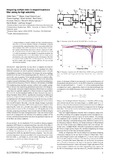Integrating multiple stubs in stepped-impedance filter aiming for high selectivity
Fecha
2022Autor
Versión
Acceso abierto / Sarbide irekia
Tipo
Artículo / Artikulua
Versión
Versión publicada / Argitaratu den bertsioa
Identificador del proyecto
Impacto
|
|
10.1049/ell2.12517
Resumen
A design technique to include multiple and fully-controlled transmission zeros (TZs) in the frequency response of rectangular waveguide commensurate-line stepped-impedance filters is presented in this letter. These bandpass filters (BPFs) are known for having reduced sensitivities against manufacturing inaccuracies and are composed of multiple waveguide sections. In order to improve their selecti ...
[++]
A design technique to include multiple and fully-controlled transmission zeros (TZs) in the frequency response of rectangular waveguide commensurate-line stepped-impedance filters is presented in this letter. These bandpass filters (BPFs) are known for having reduced sensitivities against manufacturing inaccuracies and are composed of multiple waveguide sections. In order to improve their selectivity, 3λg/4 and λg/4-stubs are included to create multiple TZs around the passband. The proposed technique allows us to add multiple stubs in a single section and, therefore, only minor adjustments in the affected part of the filter are required, which simplifies the overall design process. The technique has been verified with a design example with four TZs (two on each side) near the passband. [--]
Materias
Waveguide filter,
Stepped-impedance filter,
Bandpass filter,
Transmission zero,
Stub
Editor
IET Wiley
Publicado en
Electronics Letters 58: 554-556
Departamento
Universidad Pública de Navarra. Departamento de Ingeniería Eléctrica, Electrónica y de Comunicación /
Nafarroako Unibertsitate Publikoa. Ingeniaritza Elektrikoa, Elektronikoa eta Telekomunikazio Ingeniaritza Saila /
Universidad Pública de Navarra/Nafarroako Unibertsitate Publikoa. Institute of Smart Cities - ISC
Versión del editor
Entidades Financiadoras
This work was supported by the Spanish Ministerio de Ciencia e Innovación –Agencia Estatal de Investigación (MCIN/AEI/10.13039/501100011033) under Project PID2020-112545RB-C53 and by the European Union’s Horizon 2020 Research and Innovation Program under Grant 811232-TESLA-H2020-MSCA-ITN-2018.








